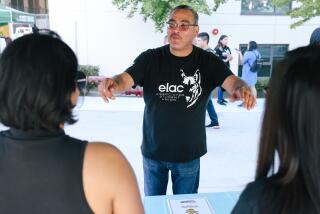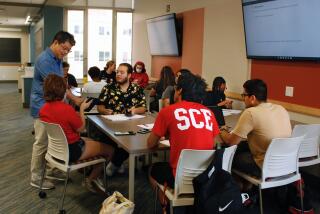Experiment Gives Edge to Internet ‘Classroom’
- Share via
In a unique new study on the effectiveness of teaching via the Internet, Cal State Northridge students randomly assigned to take a social statistics class by computer scored a whopping 20 points higher than those who took the same course in a traditional classroom.
The reason for the difference probably has less to do with any inherent “teaching” capabilities of the computer, the author and other experts said. Instead, students in the “virtual” class were forced to interact more, in this case electronically.
“They had to learn coping mechanisms for not having me in the classroom five hours a week,” said the study’s author, CSUN sociology professor Jerald G. Schutte. “One of the ways they coped is they ended up developing [on-line] peer groups--almost support groups.”
The “technology didn’t magically get the kids to learn more without effort,” said Dave McArthur, a Rand Corp. computer scientist who studies computers in education, after reviewing the study.
“Rather, the technology motivated them to work harder and longer, and to talk with their peers--always a good way to promote learning.”
While numerous studies have sought to measure the effects of computer instruction on student performance, experts say, most have been based either on anecdotal evidence or comparisons between somewhat unrelated groups--a traditional class, say, compared with a class that students knew beforehand would be taught via computer.
Students who owned a computer and were comfortable operating it, the thinking goes, would be more likely to enroll in the on-line class, skewing the data from the outset.
Schutte’s study, which comes as Gov. Pete Wilson and California State University consider building an entire university in cyberspace, attempted to limit some of the variables that have plagued other such experiments.
For the fall semester, he intentionally over-enrolled his Sociology 364 class, and on the first day randomly divided the students into two groups.
One group met in a CSUN classroom for 4 1/2 hours every Saturday for the next 14 weeks. The other met again the next week to learn computer skills, and again to take the mid-term and final exams.
The rest of the time they gathered in cyberspace.
Texts, lectures and exams were the same for both groups.
And all students had filled out questionnaires the first day of class, revealing no marked differences between the two groups in categories that might affect performance, such as age, comfort level with math and computers, and grade point average.
Schutte expected the on-line students to struggle more than their traditional classroom counterparts, especially on the mid-term, since two of their first seven weeks were taken up learning how to navigate the virtual classroom and more time was lost dealing with glitches in new software.
Instead, the average on-line student scored 72.31 on the mid-term exam, and the average student in the traditional class scored 54.76.
The trend continued through the final exam, with the average on-line score 81.56, compared with 61.35.
Additionally, at the end of the semester, those who took the class via the Internet reported they had spent more time studying and felt they had a better understanding of the material.
Despite Schutte’s efforts to control the parameters of the study, any number of factors could have influenced the results, he said, from his own classroom style to the fact that part of the on-line class evolved into a social clique as the semester went on.
But with a difference so marked that the grading scale had to be radically adjusted for the different groups, more such studies are warranted, Schutte said.
“The key here may be that there are many ways to facilitate the learning process,” he said. “I don’t think that any one of them is a panacea.”
More to Read
Sign up for Essential California
The most important California stories and recommendations in your inbox every morning.
You may occasionally receive promotional content from the Los Angeles Times.










